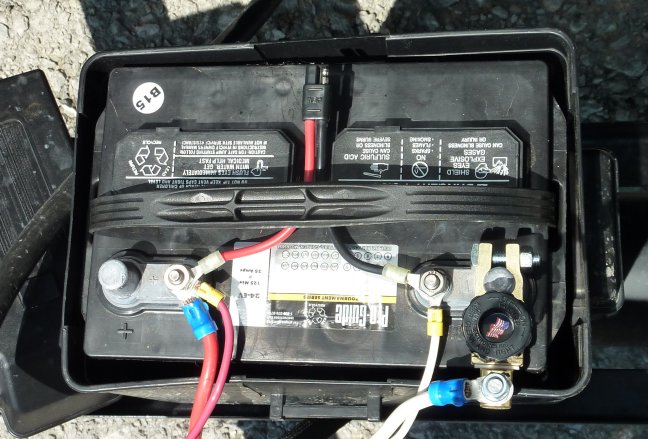Thank you for the comments on a fuse or switch vs a connector. After pondering the options, a switch made more sense as the only time the battery comes out is for winter storage.That's now been installed.
But a little investigative testing:
Solar connector - it appears that this is wired directly to the battery. At the dealership they indicated it went to the inverter but I've read conflicting comments elsewhere. Continuity checking suggests it's a straight shot from the rear connector to the battery. If either of the extra leads to the battery are removed, voltage and continuity to the rear connector is lost.
The connector itself is a standard 2-wire trailer connector available at most auto supply stores. Most of those are 16ga. A better option would be ~ 12ga which is readily available on-line usually as a 3ft extension. Just cut off the end you need for an adapter and crimp the other end for whatever is needed. I added a connector at the battery so the solar panel can be located at either end of the R-Pod. Both the rear and added connector are on the screw-down terminals.
Our Renogy panel came with the proper connector - which was a surprise. Normally they are supplied with an Anderson type connector but this one is plug-compatible with the R-Pod. Works fine at either end and was pumping ~ 5.5A into the battery most of Tuesday.
The interrupt switch is a convenient mount and is in the negative line. Mounted the way it's shown still allows the wires to exit the battery container conveniently. Snug the screw down and the circuit completes. Back it off ~ 1/4 turn or more and it's open.
When left in the yard on Sunday evening (after our first outing), the battery indicated fully charged - both with the R_Pod panel and my VOM. By Tuesday it was down ~ 0.5V but still indicating fully charged on the panel. Today (Thurs) it's down another 0.5V and the R-Pod panel shows 3/4 charge.
A measurement with my meter shows a 'quiescent current' draw of ~ 150mA - which translates to ~ 3.6A-H/day. As the battery is 60A-H, that suggests 4 days would drain about 1/4 of the capacity.
So everything is consistent and leaving the battery hooked up - with all the circuit breakers thrown - will still kill the battery in about 2-3 weeks time.
I'm sure this is pretty well known out there but just thought I'd fill in some numbers as an example.
I'll attach a pic of the battery setup if I can figure out how to do that.
Thank you again for the helpful suggestions!





